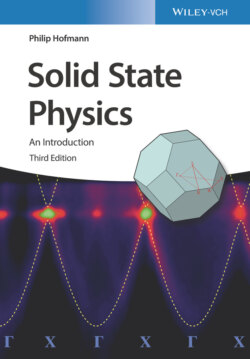Читать книгу Solid State Physics - Philip Hofmann - Страница 46
Problems
Оглавление1 2.1 Ionic bonding: Calculate the potential energy for an ion in a sodium chloride crystal (the interatomic distance is 2.81 Å) in units of electron volts and joules. Neglect the influence of the repulsive potential. From this, calculate the lattice energy of sodium chloride and compare the result to the experimental value of 776 kJ . Also, calculate the cohesive energy in the same units.
2 2.2 Ionic bonding: The Madelung constant for a three‐dimensional NaCl crystal was given in Section 2.2. (a) Derive the Madelung constant analytically for a one‐dimensional NaCl chain as the one shown in Figure 2.5. (b)* Calculate the Madelung constant numerically for a one‐dimensional, two‐dimensional, and three‐dimensional NaCl lattice and plot the result as a function of the number of neighbor “shells” included in the computation. Compare the result for the one‐dimensional case to the analytical value from part (a).Figure 2.5 One‐dimensional chain of ions.
3 2.3 Covalent bonding: (a) Given the linear system of equations (2.7) and the solution in Eq. (2.8), show that for the bonding “” solution and for the antibonding “” solution . (b) We could thus choose the resulting wave functions to be , but these are not normalized. Calculate the proper normalization factor, assuming that the atomic wave functions and are normalized.
4 2.4 Metallic bonding: The most important contribution to the stability gained by metallic bonding is the lowering of kinetic energy. To verify this, consider an electron in a one‐dimensional box, inside of which the potential is zero and outside of which the potential is infinite. Consider first a box with a length corresponding to the size of an atom – say, twice the Bohr radius – and calculate the lowest energy eigenvalue (you can consider any standard text in quantum mechanics for help with this problem). Give the result in electron volts. Clearly, this energy is only kinetic energy. By how much is the kinetic energy lowered when you increase the size of the box by a factor of 10, so that it is roughly the size of the interatomic spacing in a crystal?
5 2.5 Van der Waals force: Show that the bonding energy due to the van der Waals force between two atoms depends as on their distance . Hint: The van der Waals force is caused by the mutual interaction of fluctuating dipoles. Suppose that a spontaneous dipole moment arises in one atom at some time. This can be modeled as two point charges separated by a distance . This electric dipole gives rise to an electric field , by which the other atom is polarized such that a dipole moment is induced in this second atom. is proportional to the field, that is, [see Eq. (9.4)]. The potential energy of an electric dipole in an electric field is . Therefore, all you need to show is that the electric field caused by the dipole in the first atom decays as for .
